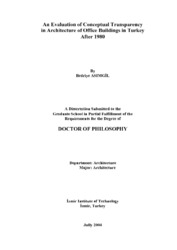Please use this identifier to cite or link to this item:
https://hdl.handle.net/11147/2920Full metadata record
| DC Field | Value | Language |
|---|---|---|
| dc.contributor.advisor | Eyüce, Özen | - |
| dc.contributor.author | Asımgil, Bedriye | - |
| dc.date.accessioned | 2014-07-22T13:48:36Z | - |
| dc.date.available | 2014-07-22T13:48:36Z | - |
| dc.date.issued | 2004 | en |
| dc.identifier.uri | http://hdl.handle.net/11147/2920 | - |
| dc.description | Thesis (Doctoral)--İzmir Institute of Technology, Architecture, İzmir, 2004 | en |
| dc.description | Includes bibliographical references (leaves: 135-138) | en |
| dc.description | Text in English; Abstract: Turkish and English | en |
| dc.description | xv, 138 leaves | en |
| dc.description.abstract | It has been known that today.s transparent building modelling and constructions have been inadequate to expression the transparent building characters in Turkey to date that overwhelmingly those office buildings. The major reason is probably that the lack of conceptual parameters that could be the real factor in the explanation of .transparency.. It has not been efficiently considered in the modelling process.The evaluation of transparency that is constructed by variable transmission glasses in Turkey and the capacity of design criteria of transparent walls are the main aim of this study. These evaluations and interpretations can be used as references for determining the design criteria and applying of transparent architecture and scientific researches. By this study, the selected office buildings are classified according to the last term applications of transparent architecture. The classified office buildings are been evaluated according to the questionnaire study. As a result, the building.s transparency depends on whether it is sufficient or insufficient. Architects. point of view to transparency will be help to building.s classification and evaluation. There is post-modern basis for these classifications.This thesis study as a normative one offers basically a methodological approach that can be integrated to the normal models: The application of conceptual modelling process for the office building is necessary for determination of transparent design policy.In the first part of this study, the aim, context and development of the thesis are explained. The second part of this study consists of etymological, historical and conceptual studies.In the third part of this study, conceptual modelling for transparency in West is explained and determined in a systematic manner. Eric Gans's and Raoul Eshelman's approaches on transparency concept is the basis for perceptual modelling. In the fourth part of this study, the architectural conditions are determined in Turkey after 1980 from the point of transparency.s application. The evaluation criteria of transparency in Turkey have been explained and determined in development phase since 1980. The office buildings constructed after 1980 are been classified according to Post-modern trend. The relation between building surface and architectural space concerning perceptual reading is been analysed.In the fifth part of this study, case studies on office buildings by variable transmission glasses that were researched and classified in Turkey are presented. A general evaluation office building in Turkey was made after 1980. According to the questionnaire study, the answers given by the architects are directed to determine the transparency.s position in Turkey. The answers of questionnaire study are the main determinant in definition of transparency concept in Turkey.As a result of this study, though more than expected, the conceptual transparency criteria has not been observed in transparency of office buildings in Turkey after 1980. It is observed not surprisingly that transparent design formulations playing around the commercialisation are related with employer.s demands. More frequent trials with better conceptual formulations as well would have ended with better designs. | en |
| dc.language.iso | en | en_US |
| dc.publisher | 01. Izmir Institute of Technology | en |
| dc.rights | info:eu-repo/semantics/openAccess | en_US |
| dc.subject.lcc | NA6234.T9 .A79 2004 | en |
| dc.subject.lcsh | Office buildings--Turkey | en |
| dc.subject.lcsh | Transparency in architecture--Turkey | en |
| dc.title | An evaluation of conceptual transpareny in architecture of office buildings in Turkey after 1980 | en_US |
| dc.type | Doctoral Thesis | en_US |
| dc.institutionauthor | Asımgil, Bedriye | - |
| dc.department | Thesis (Doctoral)--İzmir Institute of Technology, Architecture | en_US |
| dc.relation.publicationcategory | Tez | en_US |
| item.openairecristype | http://purl.org/coar/resource_type/c_18cf | - |
| item.grantfulltext | open | - |
| item.cerifentitytype | Publications | - |
| item.fulltext | With Fulltext | - |
| item.openairetype | Doctoral Thesis | - |
| item.languageiso639-1 | en | - |
| Appears in Collections: | Phd Degree / Doktora | |
Files in This Item:
| File | Description | Size | Format | |
|---|---|---|---|---|
| T000512.pdf | DoctoralThesis | 5.27 MB | Adobe PDF |  View/Open |
CORE Recommender
Page view(s)
168
checked on Nov 18, 2024
Download(s)
332
checked on Nov 18, 2024
Google ScholarTM
Check
Items in GCRIS Repository are protected by copyright, with all rights reserved, unless otherwise indicated.